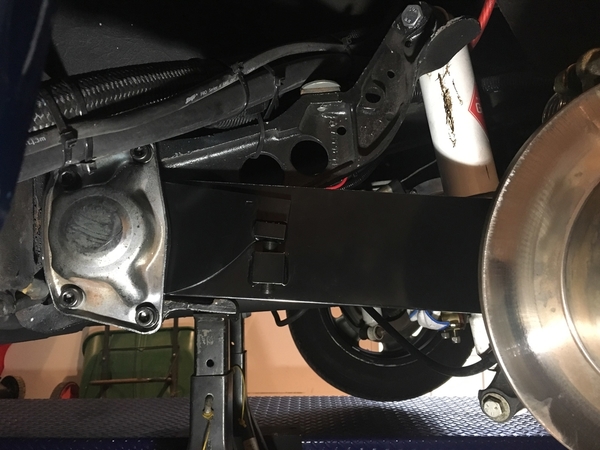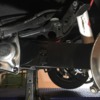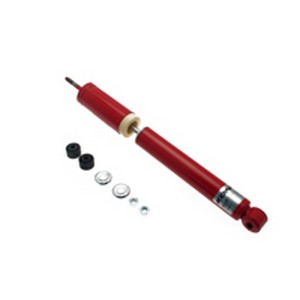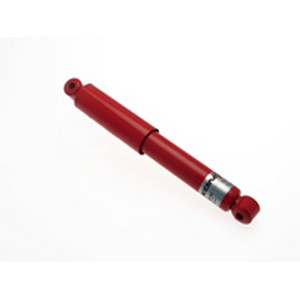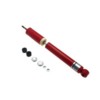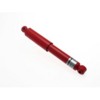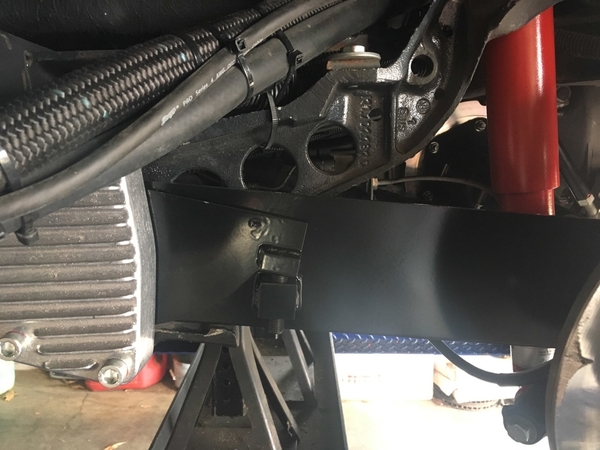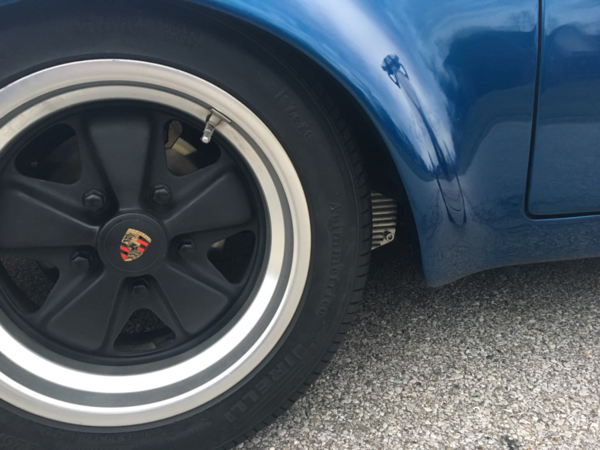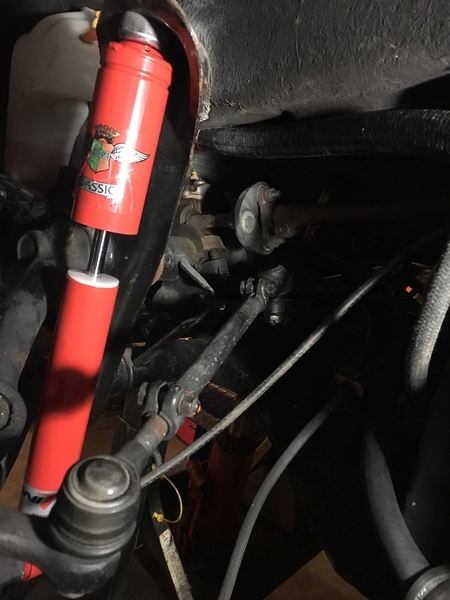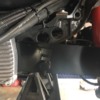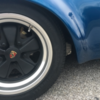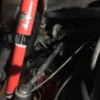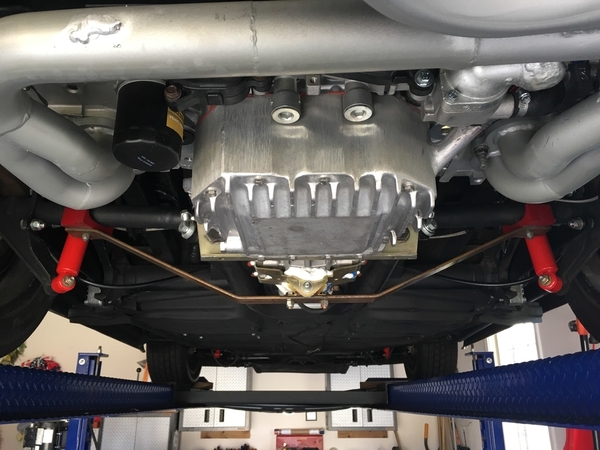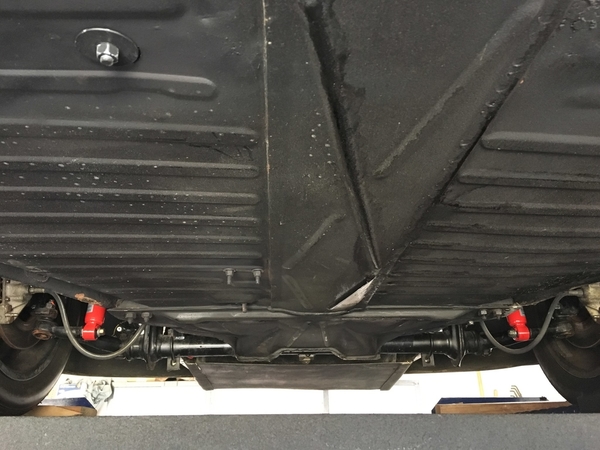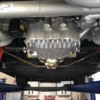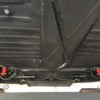My Speedster has settled in the rear some 5 months after the completion of my Subaru conversion. The rear tires have so much camber (Tilted in) that only the inner 1/3 of the tire was making contact with the ground. After investigation and thought I decided to install adjustable spring plates instead of just adjusting the torsion bar settings to raise the rear of the car. I liked the idea of having small adjustments in the rear ride height available. I went with the Empi adjustable plates. They are made of 1mm thicker hardened steel and may be 1-1.5 lbs heavier. I say so what, I am not building a race car and decided the little bit of extra weight is worth the benefit. They do appear to be stronger and more rigid than the stock spring plates so that is a plus also. I didn't like the cheap silver paint job the spring plates came with so I sent them out to have a local company powder coat the plates semi-gloss black. They did a nice job. The spring plate's adjustment feature is designed have more adjustment in the lowering direction if installed set as stock plates so I needed to drop down one tooth on the outer spline from where the stock plate was set. This raised car enough so I could adjust the spring plates in the lowering direction to arrive at the perfect ride height. The axles are now parallel to the ground and all of the rear tire is making contact. I am also happy with the way the new spring plates look. I have ordered a pair of nice cast aluminum torsion bar covers to replace the stamped steel covers I now have. I think they will really finished the job off nicely. I hope this is of use to others who might be thinking of doing this as well. The job wasn't all that hard. I did it alone in my garage in an afternoon. Your mileage may vary. I will post some pictures when the new torsion covers arrive next week.
Replies sorted oldest to newest
Nice work!!
Nice work, Jimmy! ![]() @Jimmy V.
@Jimmy V.
Good for you, Jimmy. What rear end ground clearance will you now have ? How is the rear stance comparing with the front stance ?
Not sure about the rear ground clearance measurement it wasn't an issue even in the lowered condition. I just didn't like the extreme camber situation. The car is about 1.500" higher than it was which was enough to remove all but a slight amount of camber. The rear fender lip was covering 2" of the tire sidewall, now the fender covers about 1/2" of the tire and the car has a slight rear to front rake. It was nice to have the job come out perfect. I was concerned that one spline tooth would raise the rear too high and I would need to do it all over and move the inner spline up one tooth. I will post some additional pics soon. Thanks for the comment.
That 1.5” is enough to change your caster settings significantly, making the car feel a bit squirrelly. You may want to consider reducing it a bit or installing some caster shims.
Ok you have me, what does caster have to do with this ? I thought caster was something important on the front wheels. Please advise how and why caster is set or shimmed on a swing axle car? The camber changes as the axle move up and down through an arc. My car was sitting so low the wheels were tilted in probably 7-10 degrees. Now they have about 1-2 degrees camber.
You are right, Jimmy; I think Lane's a bit confused. Caster is so important in these cars (for it's own reasons) but has nothing to do with rear suspension settings.
Since we are on the topic, though- do you know how much caster the front end has? Are there shims under the bottom beam?
PS- the adjustable spring plates do look way better powder coated. Are the torsion bar covers you're taking off original VW?
My front beam does have the shims and is set correctly. The car drives great at all speeds. The torsion bar covers I am taking off are not OEM VW but cheap Chinese ones. Thanks for your input to clarify Lane's post.
Raising the rear of a car does affect caster, because caster is relative to a flat horizontal line. If the back of the car sits lower than the front, caster will be increased. If the back of the car sits higher than the front, caster will be decreased. Raising the back 1-1/2” probably decreased the caster 1/2- 1°, maybe less.
However, if you had 10° of negative chamber, raising the back to get it to 1 or 2° will definitely help with tire wear, etc.
The thing with alignment is that everything affects everything else. I have an IRS rear end, and had my car slammed. The rear was set at 7° negative camber. The handling was fantastic, but I was only able to get about 7500 miles out of a set of rear tires. When I switched to the Vredesteins, I took as much the negative camber as I could out of the car, without raising the back of the car more than I wanted. I’m out of adjustment, and still at 3-1/2° (+/-). I had to raise the back about an inch to get that. The only way to get more is to bring the back up. Bringing it up more would take out some front caster, and I don’t want that, nor do I want the center of gravity to get higher.
I think I probably would’ve done something very similar to what Jimmy did here, but Lane is right – it did affect caster.
Ok That makes sense , Lane didn't mention the front end in his post ,so I asked the question. In my case I have now brought my car back to the ride height was before the suby conversion, the caster was set correctly before the conversion and now should be as well. So all is well the ends well.
I have a question for you Stan, I was thinking of getting rid of my KYB gas shocks and installing a set of red Koni adjustable shocks. Do you have any experience (this is directed to all as well) with the Koni shocks, would it be worth the cost of almost $600.00 ? Will there be a noticeable improvement in performance and ride quality?
I put Bilsteins in the back and Konis in the front. Bilsteins are a bit stiffer so they work great where there is more weight. Penny rides a bit harsher than before but she sits a lot lower now and I didn't want the sump slapping the pavement. Although stiffer now, Penny is more responsive through the twisties.
Stan Galat posted:Raising the rear of a car does affect caster, because caster is relative to a flat horizontal line. If the back of the car sits lower than the front, caster will be increased. If the back of the car sits higher than the front, caster will be decreased. Raising the back 1-1/2” probably decreased the caster 1/2- 1°, maybe less.
However, if you had 10° of negative chamber, raising the back to get it to 1 or 2° will definitely help with tire wear, etc.
The thing with alignment is that everything affects everything else. I have an IRS rear end, and had my car slammed. The rear was set at 7° negative camber. The handling was fantastic, but I was only able to get about 7500 miles out of a set of rear tires. When I switched to the Vredesteins, I took as much the negative camber as I could out of the car, without raising the back of the car more than I wanted. I’m out of adjustment, and still at 3-1/2° (+/-). I had to raise the back about an inch to get that. The only way to get more is to bring the back up. Bringing it up more would take out some front caster, and I don’t want that, nor do I want the center of gravity to get higher.
I think I probably would’ve done something very similar to what Jimmy did here, but Lane is right – it did affect caster.
You can gain camber back on a lowered IRS car by switching the control arms side to side. This entails removing the shock mount from the arm and rewelding. Also need to drill a new hole where the arm mounts to the spring plate.
When I narrowed a couple of pairs of arms, I reindexed the bearing carrier to remove the camber. Doing this, you can get the car very low and have a flat contact patch of tire to ground.
Li-Rick,
You sir, are the man.
Jimmy V. posted:I have a question for you Stan, I was thinking of getting rid of my KYB gas shocks and installing a set of red Koni adjustable shocks. Do you have any experience (this is directed to all as well) with the Koni shocks, would it be worth the cost of almost $600.00 ? Will there be a noticeable improvement in performance and ride quality?
Terry Nuckels posted:I put Bilsteins in the back and Konis in the front. Bilsteins are a bit stiffer so they work great where there is more weight. Penny rides a bit harsher than before but she sits a lot lower now and I didn't want the sump slapping the pavement. Although stiffer now, Penny is more responsive through the twisties.
I've got Konis on all 4 corners, and love them-- but I've got a dry-sump, so I can sit lower and still have decent ground clearance.
With the heavier engine, and a wet sump, you may have better luck with Terry's most excellent set-up. Really, everybody here ought to listen when Terry recommends something. Everything (and I mean every last thing) he's done to his car has made it much, much better.
I have intermittent availability and couldn’t get back in time to clarify my statement. I’m glad Stan did so. When first got my car I had it jacked up a bit to clear the driveway, but the steering was awful. Lowering the rear also changed the caster up front and drastically improved steering feel.
Al needs to go and count some gear teeth for a while. Then drill some more holes in something LOL.....
I have the old Koni front adjustable non-gas shocks. They are set on the softest setting and work fantastic on my Spyder. I highly recommend them.
I like what Rick is saying about flipping the rear control arms. Makes perfect sense to me.
I stand by my statement above that front caster is a separate entity from rear suspension settings, although people are correct in that changing rear ride height (either up or down) does affect said caster setting.
@LI-Rick- I've heard of people flipping irs trailing arms upside down on lowered cars- do you know how much the camber changes when lowered 1-2" from stock? When you've narrowed trailing arms how much did you move them to re-index the bearing carriers?
And @DannyP-
Attachments
"...although people are correct in that changing rear ride height (either up or down) does affect said caster setting. "
Which is all I'm sayin', so
I LOVE that GIF! See you in Carlisle this year, Al?
Attachments
Stan Galat posted:Raising the rear of a car does affect caster, because caster is relative to a flat horizontal line. If the back of the car sits lower than the front, caster will be increased. If the back of the car sits higher than the front, caster will be decreased. Raising the back 1-1/2” probably decreased the caster 1/2- 1°, maybe less.
84" Wheel base with the rear getting raised 1 1/2" will change angle at the front by 1.036 deg. according to one online calculator.
I would certainly like to, but don't know yet, Lane. Among other things, my daughter graduates from high school this year and I have to check which weekend the festivities are. I'm a procrastinator; what can I say...
PS- It's May 17-19?
ALB posted:@LI-Rick- I've heard of people flipping irs trailing arms upside down on lowered cars- do you know how much the camber changes when lowered 1-2" from stock? When you've narrowed trailing arms how much did you move them to re-index the bearing carriers?
Stock IRS trailing arms are approximately 1.5 degrees negative at the bearing carrier. I set mine at 1 degree positive. This net 2.5 degree move allowed for a much flatter footprint on the pavement. The alignment came out to about 1 degree of negative camber when reinstalled on the lowered car.
I can't find a rear picture of the car, but this is the best view I have of the wheel/tire combo. That is a 6" wide Weld ProStar with a 205/65R15. Look at the clearance to the fender. Anyone who knows Ghia's can attest to how tight the fenderwells are.
Those pictures were taken by the new owner in the UK after he installed his motor.
Attachments
IaM-Ray posted:I wonder what pie shaped cutouts would look like on a GHia to get the rear end to have bigger wheels and tires?
I don't think it would work on a Ghia, Ray, as the bodies aren't the same in the back. On Speedsters the body gets narrower as you go back along the rear wheelwells. There's 1/2" (or a little more) difference from the front where the top of the wheelwell touches the tire to the back (and that's on each side). On a Ghia the rear fenderwells are the same distance apart from front to back (or really close).
Could be worse.... Have you seen those Infinity pregnant roller skates for a body...
IaM-Ray posted:I wonder what pie shaped cutouts would look like on a GHia to get the rear end to have bigger wheels and tires?
If you want a really big tire on a ghia, you could tub the inside wheel well and build custom trailing arms 3" narrower. How much is too much tire, that is the question?
FWIW, Ron Lummus Racing makes and sells both 1” and 3” narrowed trailing arms.
That sounds interesting Stan. Should be an option offered by builders IMO.
Stan Galat posted:FWIW, Ron Lummus Racing makes and sells both 1” and 3” narrowed trailing arms.
Those look sweet!
FWIW.. I just bought Koni Red D adjustable shocks front and rear for my Speedster. JBUGS had them listed for $147.58 each shock. I found them at Shockwarehouse.com for $97.61 each shock with Free shipping.
Attachments
LI-Rick posted:IaM-Ray posted:I wonder what pie shaped cutouts would look like on a GHia to get the rear end to have bigger wheels and tires?
If you want a really big tire on a ghia, you could tub the inside wheel well and build custom trailing arms 3" narrower. How much is too much tire, that is the question?
Kinda like too much horsepower; no such thing. Or, what is too many clamps?
...or as our favorite female SOC gearhead Angela Lane always says...'Aerodynamics is for those without enough horsepower"! ![]()
Update to the Adjustable spring plate installation.
I have the new torsion caps I bought from CB Performance installed. I have also just installed Koni adjustable shocks in place of the KYB Gas-adjust shocks that were on the car when I bought it. The ride is much nicer. I set the Koni shocks about halfway between the softest and firmest setting. I like the look of the new torsion bar caps, which are visible with the car on the ground. My old ones were after market chromed one's which are showing rust. All in all I am very happy with the upgrades.
Attachments
By The way , I found the Koni Adjustable Shocks for $88.40 each at a website called Race consulting agency. Here is the link to the front shocks 80-1787
Very nice!


